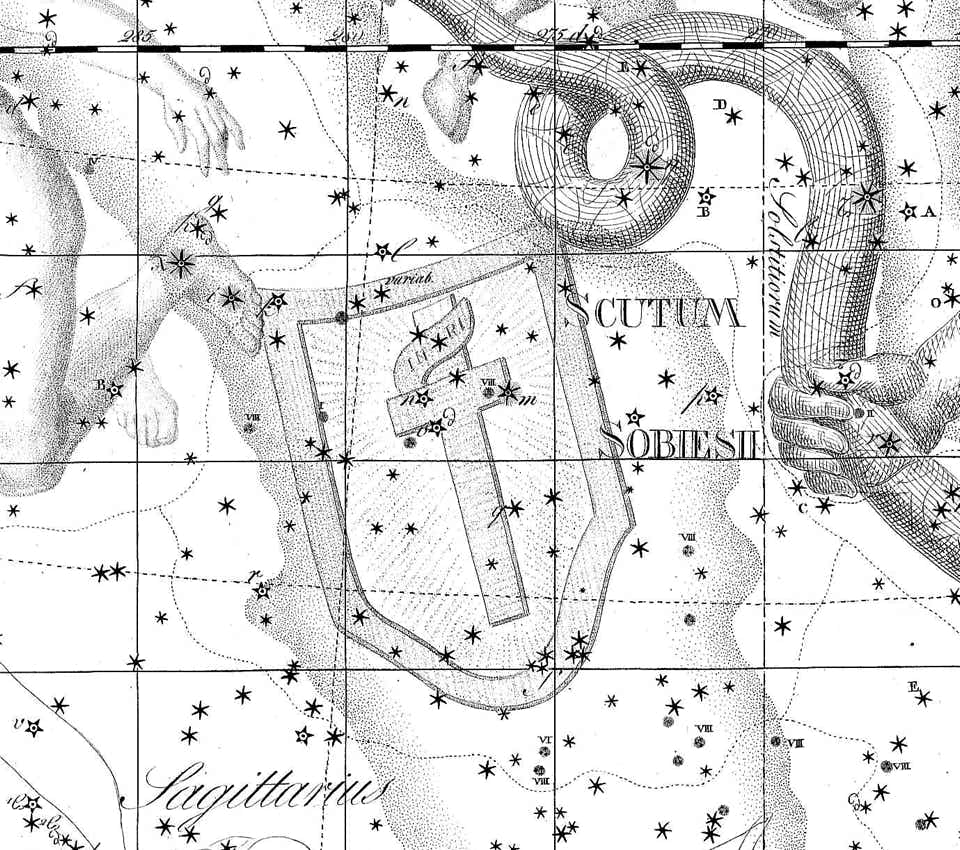
Genitive: Scuti
Abbreviation: Sct
Size ranking: 84th
Origin: The seven constellations of Johannes Hevelius
The fifth-smallest constellation in the sky, introduced in 1684 by the Polish astronomer Johannes Hevelius under the title Scutum Sobiescianum, Sobieski’s Shield. He named it in honour of King John III Sobieski of Poland who helped Hevelius rebuild his rooftop observatory after a disastrous fire in 1679 that destroyed his instruments and most of his three houses.
Hevelius’s description and chart of the constellation first appeared in August 1684 in Acta Eruditorum, a leading scientific journal of the day. Hevelius quoted Edmond Halley’s invention six years earlier of Robur Carolinum, honouring King Charles II of England, as the precedent. Robur Carolinum did not survive but Scutum did, and is in fact the only constellation introduced for political reasons that is still in use.
Even so, Scutum nearly didn’t make it. John Flamsteed, Britain’s first Astronomer Royal, ignored it in his catalogue (1725) and atlas (1729), listing its stars under Aquila, although he accepted six other Hevelius inventions. Johann Bode reinstated it to the sky in his Uranographia atlas and catalogue of 1801 under the name Scutum Sobiesii (see illustration). It was taken out again by the English astronomer Francis Baily who omitted it from his influential British Association Catalogue of 1845. This tug-of-war was resolved by the American astronomer Benjamin Gould, who included it as plain Scutum in his Uranometria Argentina catalogue of 1879 and allocated Greek letters to its stars for the first time, thereby cementing its permanence.
Scutum shown under the name Scutum Sobiesii on Chart IX of the Uranographia of Johann Bode (1801). It is squeezed between the feet of the obsolete constellation Antinous (left), Serpens Cauda (above and right), and Sagittarius (below).
Click here for Hevelius’s own depiction of Scutum.
Scutum lies in a bright area of the Milky Way between Aquila and Sagittarius and is distinctive despite its small size. Its brightest stars are of only fourth magnitude, and none are named, but the constellation contains a celebrated cluster of stars popularly known as the Wild Duck cluster because its fan-shape resembles a flight of ducks.
Chinese associations
In the Chinese constellation system five or six stars of northern Scutum, including Alpha, Beta, and Eta Scuti, were grouped with others in Aquila to form a nine-star constellation called Tianbian. This represented a team of trade officials overseeing the organization and operation of markets. The area of sky to the west, incorporating much of Ophiuchus and Serpens plus southern Hercules, was visualized as a marketplace.
© Ian Ridpath. All rights reserved



